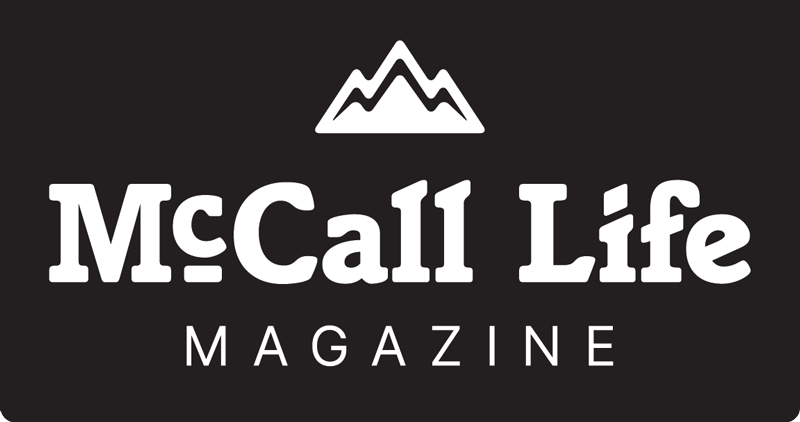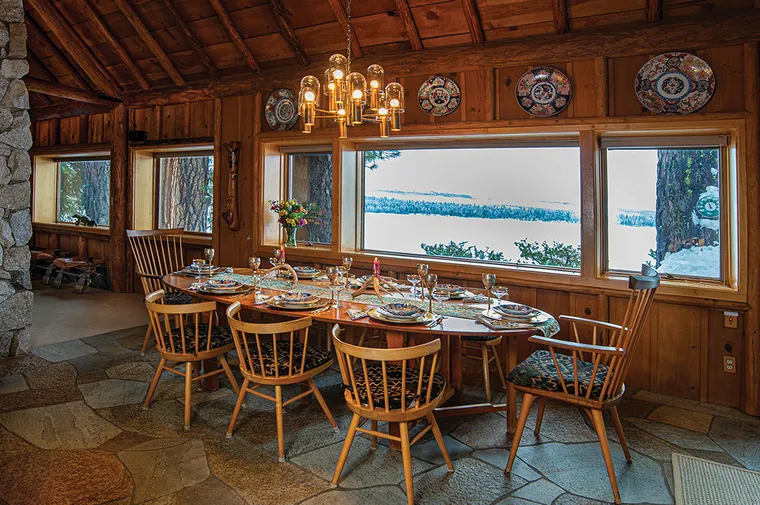Watching McCall grow from the granite terrace of an unassuming cabin on Wagon Wheel Bay
By Rodney J. Auth and Finley Tevlin
The morning sun bounces off the ripples on Payette Lake, brightens the granite terrace of the aptly named Front Cabin, and fills the dining room with warmth and beauty second only to the old-world charm infusing the entire space.
If these walls could talk, they would tell the story of the entire 20th century — and the growth of McCall from a timber and logging community to one boasting some of the best recreational opportunities in all of Idaho.
Roots In The West
The Front Cabin’s story starts in 1891 in Chicago with the birth of JL Eberle to German immigrants. JL was raised to appreciate the power of education, graduating from the University of Chicago with a law degree. His first employer, Electric Bond & Share, sent him west, first to Butte, Mont., and then to Boise in 1915, where he met Clare Holcomb.
Clare, born and raised in a small Idaho community of about 50 people (in Cassia County on the Snake River), was also a believer in the power of education, attending Stanford University and graduating in 1917. The two were eventually married at St. Mark’s Cathedral in Seattle, while JL served as an ensign in the Navy Reserve.
At the close of JL’s Navy service, the couple relocated to Boise—moving into a home on First and Idaho (where the Mountain States Tumor Institute now sits), just seven blocks from downtown—and started a family. They quickly had two sons and then, 11 years later, a daughter. During that time, JL joined the Richard and Haga Law firm, which led to his increased involvement in the Boise community, becoming president of the Boise Chamber of Commerce, president of the Boise School Board, member of the Idaho Board Association and American Legion, and potentate of the Shriners. He was a chancellor for the Episcopal Church of Idaho and helped raise funds for St. Michael’s Church.
Eberles In McCall
In 1928, JL visited McCall looking for a respite from the heat of Boise summers. He fell in love with the recreational opportunities available in our picturesque little town and purchased the land on Wagon Wheel Bay from the State Land Board after the area was platted in 1933.
The site, just south of Wagon Wheel Creek, was covered with a grove of large Ponderosa pines, which JL’s sons (Bill and Ted, 11 and 12 at the time) helped fell to build the original two-room cabin (with the help of carpenters). Placed just above the high-water line, the cabin had a main room, a stone fireplace and chimney, and a kitchen with sleeping quarters above for the children. A small bedroom was attached on the north side of the living room. The main room was notable for its large, exposed log rafters jointed by iron rivets and cut pine boards up to 20 inches wide. It was heated by the woodstove and had no electricity, nor was it insulated. It did have large windows along the side of the house facing the lake, impressive mountain views, and a terrace built from uncut granite stones found locally. The home and terrace were built around six large Ponderosas, which the family left standing for shade and atmosphere.
Much like today, summers were spent swimming, picking huckleberries, relaxing on the beach, hiking, and sailing.
JL is believed to be the first person to have a private sailboat on Payette Lake. Named the NancyClare after his daughter and wife, JL launched his sailboat using a narrow-gauge rail track that led from the wooden boathouse beside the cabin to the water. Similar structures were later built on Sylvan Bay.
In 1938, JL’s sons found work ferrying actors filming Northwest Passage from their cabins at Sylvan Beach Resort (just north of Wagon Wheel Bay) to locations around the lake in a motorboat. The boys were well-regarded by the actors and crew despite having “accidentally” sailed the NancyClare into one of their live shoots.

Ponderosa State Park Created
JL’s connections in Boise followed him to McCall. He often hosted and entertained notable guests at the family cabin, including Harry Shellworth of the Southern Idaho Timber Protective Area (SITPA) and McCall’s CCC camp, Governor C. Ben Ross, and Idaho Senator William Borah.
One family story describes an evening when JL and Clare had drinks on the terrace with Governor Ross. While looking out across the lake at the opposing peninsula, he said, “That whole thing ought to be a park!” Governor Ross was then instrumental in developing the first campsites and access roads with the CCC and ultimately urging the National Park Service to create the Master Plan and Development Outline for Payette Lake State Park on behalf of the state of Idaho in March 1941 — what we now know as Ponderosa State Park.
Payette Protective Association Formed
In the 1940s, mechanized agriculture in Long Valley and further south used an increasing amount of water stored in Payette Lake for irrigation. A dam on the Payette River at Lardo (at the outlet of Payette Lake) was built in 1920, but washed out in August 1943, dropping the lake level two feet in one day. The dam was rebuilt, but the conflict was not resolved.
The irrigation districts kept the lake “unseasonably high,” often above the natural high-water mark in the spring to store as much water as possible and then drained the water throughout the summer to levels far below the winter low by the fall. This was a danger to both homeowners who feared flooding and erosion due to high water levels, as well as to boaters concerned with new obstacles exposed at low water levels (especially rocks off the Ponderosa Peninsula).
Applying his skills as an attorney and deal maker, JL worked with homeowners and recreationists to organize the Payette Lakes Protective Association and file a lawsuit against several irrigation districts, which was successful in 1948 and ultimately limited fluctuation of the lake level within its natural high- and low-water marks[i].
The Next Generation
Time, as it does, wound along, and the kids grew up.
The boys, Ted and Bill, went off to war (Bill in the Navy, Ted in the 10th Mountain Division) and then to careers in business and politics. Bill served in the Idaho House of Representatives and as the (first Idahoan) Trade Ambassador during the Nixon and Ford administrations.
Nancy, JL and Clare’s only daughter, went to Wellesley College in Massachusetts and fell in love with Cutler Umbach, who attended Williams College. They sealed their engagement on the terrace of The Front Cabin; Nancy followed him to work in Chicago, but they kept up their lengthy stays in Idaho and at the cabin on Payette Lake.
Four-Season Town
In 1959, businessman Warren Brown and Norwegian ski champion Corey Engen became interested in starting a larger and steeper ski hill near McCall. With help from U.S. Forest Ranger Wally Lancaster and investment from Jack Simplot, they opened Brundage Mountain on Thanksgiving Day, 1961.
Cutler remembers being newer to skiing, but Nancy was very adept, having skied in Sun Valley and McCall for years as a child. On opening day, they skied together with Brown, Simplot, and two others down one of the two cleared runs, when Cutler fell into a tree well. The others continued down, took the chairlift up, and came back to find him still in the tree well and jumped to his aid! Wanting to teach their four kids to ski, Cutler and Nancy helped winterize the cabin in 1965 by adding insulation to the outside of the walls and building a new exterior. They added another bedroom with a fireplace insert and turned the boathouse into a garage. Misfortune struck when JL was hit by an automobile while crossing the street in downtown Boise. He passed away from complications in 1964 at 73. In response, a small “mother-in-law” unit was built behind the main cabin for Clare when she visited McCall.
The ‘70s Downturn
McCall experienced an economic downturn in the 1970s, with the closing of the Boise Cascade Mill in 1977. This was especially unfortunate as Bill had been a co-founder of the Boise Cascade Pulp Company, which purchased the mill in 1964. However, by 1977, Bill had officially moved into politics. Sadly, this was also the year Ted passed away when his small single-engine plane crashed in Arizona.
The economic downturn also impacted the Umbachs, causing Cutler’s business, Superior Concrete Accessories, to significantly downsize and reorganize. With their kids mostly through school, Cutler went back to school himself at Northwestern University to obtain a Ph.D. in organizational behavior.
However, recreational opportunities began to fill the economic void left by the timber industry in McCall with the popularization of backpacking, whitewater rafting, and mountain biking. The Umbachs decided to commit to Idaho and its opportunity, and moved to the area full-time from Chicago in 1982.
At a petting zoo during a trip to California, they encountered a llama for the first time, and it occurred to Nancy, “We could raise these in Idaho!” The family had been taking backpacking trips into the Salmon River Mountains near McCall for many years, often taking two or three trips up and down the trail to bring all their kids, camping gear, and fishing equipment. Nancy was also very talented with fabric arts, knitting, sewing, and embroidering. They decided that by keeping llamas, they could train them to pack in their gear for backcountry expeditions, have a source of fine wool for Nancy’s fiber projects, and potentially breed and train them as a small business.
Llamas At Jug Mountain
In 1985, the family acquired acreage in Long Valley near Jug Mountain and began raising a small herd. They called it the High Llama Ranch. Still cherishing the cabin by the lake, they invested in a remodel of the home that would accommodate living there full-time and enable them to host their growing family. Hiring architect David Vala from Portland and McCall local Mike Walker as their contractor, Nancy worked closely with them to design updates to the home that would retain the integrity of the original cabin and draw attention to the grand mountain views. Some of these included adding two wings to the main structure to form a horseshoe shape that surrounded a small courtyard, where they planted several spruce trees and other native plants. The main bedroom was turned into a sitting room with a loft that housed Nancy’s loom, where she weaved many fabrics using wool from the llamas. The boathouse and garage were enclosed to make a sunroom and guest bedroom. The sleeping porch above the kitchen was shrunken to open the ceiling above the dining room, and the leftover area became an office for Cutler.
Two other additions were a master bedroom and family library for maps, books, and images. The mosaic of inlaid granite from the terrace was replicated in the stone floors throughout the house, and the bark-stripped lodgepole beams seen holding the Ponderosa boards of the living room ceiling were used again throughout the house, along with tongue-and-groove wood paneling. The architecture highlighted the family’s collection of art and musical instruments from around the world, and added an inspiring tone to this unique residence. A finishing touch was refurbishing a hanging, antique wagon wheel-turned-chandelier in the living room, which references the bay’s history.
Another McCall local, Art Troutner, was an apprentice carpenter on the build and recalls the detailed work required for the custom tree-branch design on the frame and handle of the glass front door, which indicates visitors are entering a cabin filled with wonder. The original Ponderosa trees on the terrace loomed even larger, including one that had grown so much in girth it now touched the house’s eaves. Instead of cutting the tree, the eave was trimmed back to make room for the expanding trunk. It is family lore that McCall residents have the loggers’ wives to thank for the trees’ continued presence: after camping underneath them while the men were at work, they pleaded with the loggers to spare them. Though others say the loggers left the lakeside giants because the nails in the trunks from their camp likely would have broken the mill’s saws.
McCall Music Society & Payette Protective League
Now firmly planted in McCall, Nancy and Cutler became very involved in the community. Nancy’s lifelong love of music (and incredible banjo skills) translated into a friendship with Jim Cockey, a local composer. Nancy and Jim were on the board that ran the McCall Music Society, putting on a multitude of concerts at the Congregational Church, Alpine Playhouse, and elsewhere. Nancy often hosted musicians travelling to McCall for their concerts at their house on Sharlie Lane. One notable guest was Idaho folklorist and musician Rosalie Sorrels. Cutler’s experience as an organizational development consultant for non-profit and business management helped the Alpine Playhouse Theater make the McCall Arts and Humanities Council a separate entity, and then staff and fund it—work that Cutler did pro bono. Cutler also worked pro bono as a strategic-planning facilitator for several other McCall not-for-profits and the Payette National Forest.
Increased recreation on the lake brought some conflict between users. When the owner of the marina organized jet ski races, public outrage created the impetus for opposition. Cutler helped form the Payette Lake Protective League (PLPL), a 501(c)3. The organization raised money from many generous and like-minded supporters and hired a consultant from Seattle, Bo Bricklemyer. Together, they drafted a lake ordinance to regulate the safe use of the lake by multiple users and prevent overuse, and eventually got it passed by the Valley County Commissioners. The PLPL is now out of existence, but other local organizations carry on the work of protecting the lake and the surrounding area, including the Payette Land Trust, another pivotal group which Cutler helped start. While the organization lacked the funds to make large impacts when it began, Cutler has high praise for Craig Utter and the progress the group has made under Craig’s leadership.
The Umbachs enjoyed raising llamas tremendously and, at one point, had over 85 in the herd. They organized trips into the backcountry with the family and other close friends, including local legend and Forest Ranger Earl Dodds, Jr. They took excursions into the Big Horn Crags, Big Creek, White Clouds, Seven Devils, and Sawtooth Mountains, often for 14 to 20 days at a time. They experimented with operating as outfitters, renting llamas to the Forest Service trail maintenance crew. Ultimately, they fully retired from the llama business in 2005 and spent the next 15 years on Sharlie Lane entertaining many visits from their children and grandchildren. Nancy Eberle Umbach passed away in 2021, after relocating with Cutler to Tucson in 2020. The home retains its inviting charm as a secluded luxury retreat by the lake, carrying many of the family’s and McCall’s memories therein. The family’s next generation holds firm in maintaining The Front Cabin as a historical pillar of McCall.
Information, rental details, and more history can be found at www.thefrontcabin.com.
About the Author:
A Cabin and its Family History, compiled by Finley Tevlin, a great-grandson of JL and Clare Eberle, and grandson to Nancy and Cutler Umbach.
[i] Payette Lakes Protective Assn. v. Lake Reservoir Co, Idaho Supreme Court, 1948



